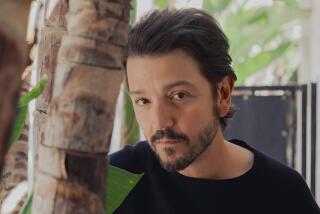Mexico was his Monument Valley
MEXICO CITY — MANY photo artists take pictures of countries. But only a few, like Gabriel Figueroa, get to invent countries, visually, with the images they create.
During his prolific 50-year career, which began as a still photographer and included a brief Hollywood sojourn, Figueroa forged a film iconography that was as elaborately crafted with calculated symbolism as a baroque altarpiece. In classic films such as “Enamorada,” “Los Olvidados,” “La Perla,” “Night of the Iguana,” “Pedro Paramo” and “Vamonos con Pancho Villa,” Mexico’s most famous cinematographer conjured an emblematic vision of his country’s landscapes, people and history.
That legacy is the subject of one of the largest-ever retrospectives of his life and work, “Gabriel Figueroa: Cinefotografo,” which opened here last month at the Palacio de Bellas Artes. The exhibition, which comprises more than 300 photos, drawings and other artifacts, including numerous film clips being looped on television screens, will be shown here through May 4. The Los Angeles County Museum of Art is considering bringing the show to L.A. in 2010.
For the show’s organizers, the problem wasn’t to make the case for Figueroa’s cultural significance, but to keep his reputation from being further embalmed in hero worship, as it has been since his death at 89 in 1997.
“In Mexico we have this little problem. Of some figures, we bury them in mountains of marble,” says Alfonso Morales, the show’s curator. “I prefer this more as a retrospective, and not as an homage.”
For decades, Figueroa’s artistry has been what much of the world pictures when it thinks of Mexico: Men on horseback, galloping furiously in the distance, framed by close-up shots of cactus plants and sculptural maguey. Shadowy montages of Indian faces, as stylized as masks. A slain revolutionary poetically draped across a machine gun. Dramatic black-and-white panoramas of postwar Mexico City, where rising office towers cast shadows over squalid slums.
Altogether, Figueroa served as photography director on more than 200 movies, earning him a virtual auteur status. During a brief stay in Hollywood in the 1930s he became friends with legendary cinematographer Gregg Toland (“Citizen Kane”), who recommended Figueroa to director John Ford for “The Fugitive.” When Toland died unexpectedly in 1948, Samuel Goldwyn invited Figueroa to work in Hollywood, but Figueroa preferred to remain in Mexico, where he had become a creative linchpin in the country’s government-run film industry.
Mexico’s government regarded movies and the visual arts as useful tools to help cauterize the nation’s wounds after the Revolution of 1910-1920. From 1932, when he started as a movie still photographer, to his final feature film project, working with director John Huston on “Under the Volcano” in 1984, Figueroa had as great an influence in shaping modern Mexican identity as the muralists Diego Rivera, Jose Clemente Orozco and David Alfaro Siqueiros and photographer Manuel Alvarez Bravo, whose images deeply influenced him. He also drew on the idealized landscapes of painter Jose Maria Velasco and the satiric drawings of master caricaturist Jose Guadalupe Posada.
Figueroa grew up in Mexico City, where he later studied painting, took up photography and eventually broke into the movie business. His talent was recognized immediately, and his vast circle of friends and colleagues turned into a who’s who of Mexico’s midcentury intelligentsia and artistic elites.
Working with Mexico’s A-list directors (including a career-making partnership with Emilio “Indio” Fernandez) as well as Huston, Luis Bunuel and other foreigners, Figueroa made comedies, tragedies, melodramas, historical epics and telenovelas.
The constant was his extravagant artifice, his method of using infrared filters and other technical manipulation to make artificial light appear natural. And just as Ford used the backdrop of Monument Valley to define the classic American Western, Figueroa invested Mexican landmarks with operatic grandeur.
That monumentalizing tendency, yoked to an autocratic government-run industry, has exposed Figueroa to charges that he was as much of a propagandist as an artist. Several prominent Mexican intellectuals and film scholars have criticized Figueroa’s approach as overly stylized and inflexible, which they equate with the rigid, government-sanctioned messages of the movies themselves.
“The famous Figueroa style I believe is a form of petrification, of authoritarianism, of imposing on reality a vision, not of taking a vision from reality,” says Jorge Ayala Blanco, a historian and film critic. Figueroa, he says, helped enshrine “a false aesthetic of Mexican-ness.”
But Mauricio Maille, director of visual arts for Fundacion Televisa, which is backed by Mexico’s giant entertainment company that supplied most of the show’s materials, says that Figueroa’s meticulously staged imagery makes him a forerunner of such contemporary artists as Cindy Sherman and Jeff Wall, who revel in cinema’s blatant falseness.
Such controversies, in any case, are nothing new for Figueroa, who is now undergoing his “third turn of appraisal,” Morales says. “The visual power of his images endures. The biography of Figueroa is the biography of the Mexican cinema industry.”
--
More to Read
Sign up for The Wild
We’ll help you find the best places to hike, bike and run, as well as the perfect silent spots for meditation and yoga.
You may occasionally receive promotional content from the Los Angeles Times.







